Monthly Archives: July 2020
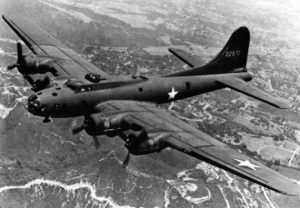
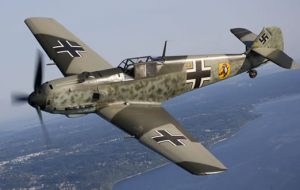 When the B-17 was built, it was designed to be a formidable weapon against the enemy, namely the Nazis and the Japanese. Early on, before long-range fighter escorts came into being, B-17s had only their .50 caliber M2, the B-17s were on their own out there. Still, the B-17 was not defenseless. With those .50 caliber M2s, the crew had the ability to fire at the enemy from every direction…almost. The job of the Messerschmitt fighters was to take down the B-17s. The Messerschmitt fighter planes were designed to break world air speed records. They were also the hope of the Germans to take down the B-17s. Still, there were all those guns to deal with. Luftwaffe fighter pilots agreed that attacking a B-17 combat box formation to encountering a fliegendes Stachelschwein, “flying porcupine,” with dozens of machine guns in a combat box aimed at them from almost every direction. The biggest downfall of the B-17 bombing formation was that they had to fly straight, making them vulnerable to German flak. It was the first line of defense the Germans had when the bombers came in.
When the B-17 was built, it was designed to be a formidable weapon against the enemy, namely the Nazis and the Japanese. Early on, before long-range fighter escorts came into being, B-17s had only their .50 caliber M2, the B-17s were on their own out there. Still, the B-17 was not defenseless. With those .50 caliber M2s, the crew had the ability to fire at the enemy from every direction…almost. The job of the Messerschmitt fighters was to take down the B-17s. The Messerschmitt fighter planes were designed to break world air speed records. They were also the hope of the Germans to take down the B-17s. Still, there were all those guns to deal with. Luftwaffe fighter pilots agreed that attacking a B-17 combat box formation to encountering a fliegendes Stachelschwein, “flying porcupine,” with dozens of machine guns in a combat box aimed at them from almost every direction. The biggest downfall of the B-17 bombing formation was that they had to fly straight, making them vulnerable to German flak. It was the first line of defense the Germans had when the bombers came in.
In a 1943 survey, the USAAF found that over half the bombers shot down by the Germans had left the protection of the main formation. The Germans needed a training plan. The United States developed the bomb-group formation, which evolved into the staggered combat box formation in which all the B-17s could safely cover any others in their formation with their machine guns, making a formation of bombers a dangerous target to engage by enemy fighters. The Messerschmitt fighters were fast, but they could not just fly at the formation. They would be shot down for sure. So, they looked for the bomber that had been hit and had to pull out of formation. Then they would move in for the kill. Moreover, German fighter aircraft later developed the tactic of high-speed strafing passes rather than engaging with individual aircraft to inflict damage with minimum risk. It was a way of not fully engaging the “flying porcupine.” As a result, the B-17s’ loss rate was up to 25% on some early missions. They needed something more to provide a kind of shield against the enemy.

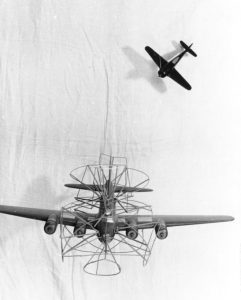
It was not until the advent of long-range fighter escorts (particularly the North American P-51 Mustang) and the resulting degradation of the Luftwaffe as an effective interceptor force between February and June 1944, that the B-17 became strategically potent. They needed the P-15 Mustang to keep the Messerschmitts off of them. So in the end, the German training didn’t do them much good against the “flying porcupine.”

 My future grand nephew, Dylan Herr comes from great stock in the business world. His family has been in the shoe business for three generations. His dad, Rob and mom, Dee Dee own nine Red Wing Shoe Stores in Colorado, and Dylan owns three, including the newest one in Brighton, Colorado. They have been in business since 1970, beginning with his grandpa, Bob Herr. They stores were recently featured by the BBB and their Featured Business of the Week. In that article, they revealed that as of 2020, they are the largest Red Wing dealer in the world. Now, that’s an amazing feat…if you’ll pardon the necessary pun, an amazing feat for the feet. I suspect that my silly pun has quite likely been heard by the Herr family many times before
My future grand nephew, Dylan Herr comes from great stock in the business world. His family has been in the shoe business for three generations. His dad, Rob and mom, Dee Dee own nine Red Wing Shoe Stores in Colorado, and Dylan owns three, including the newest one in Brighton, Colorado. They have been in business since 1970, beginning with his grandpa, Bob Herr. They stores were recently featured by the BBB and their Featured Business of the Week. In that article, they revealed that as of 2020, they are the largest Red Wing dealer in the world. Now, that’s an amazing feat…if you’ll pardon the necessary pun, an amazing feat for the feet. I suspect that my silly pun has quite likely been heard by the Herr family many times before
Dylan joined our family when he and my grand niece Katy Balcerzak became engaged recently. The were also blessed on June 14, 2020 with their first child, a son named Max Robert Herr, and he is just such a cutie!! While Dylan can’t say that his life was ever in the dumps exactly, because he has worked hard to be a success in his dad and grandpa’s footsteps…another almost pun (there seem to be a number of them in this story), having becoming engaged and having a son have to rate very high in the annals of his life history. It’s pretty hard to beat the rush of pride one feels when becoming a parent.
Dylan and Katy are such happy people. They are filled with love for each other, and for their new little son. 
 Their family is such a blessing to the rest of their families, and their happiness is a joy to watch. Dylan seems to have moved into fatherhood with ease and grace, and it’s obvious to anyone who looks at them, that daddy and son love each other very much. It makes me so happy to see Katy’s life so filled with love, and I think Dylan will make a wonderful husband for her. It is obvious to me, that when he looks at her, he is very much in love with our Katy. I am very excited for their future together, and very happy for their current lives that are so filled with joy. Today is Dylan’s birthday. Happy birthday Dylan!! Have a great day!! We love you!!
Their family is such a blessing to the rest of their families, and their happiness is a joy to watch. Dylan seems to have moved into fatherhood with ease and grace, and it’s obvious to anyone who looks at them, that daddy and son love each other very much. It makes me so happy to see Katy’s life so filled with love, and I think Dylan will make a wonderful husband for her. It is obvious to me, that when he looks at her, he is very much in love with our Katy. I am very excited for their future together, and very happy for their current lives that are so filled with joy. Today is Dylan’s birthday. Happy birthday Dylan!! Have a great day!! We love you!!
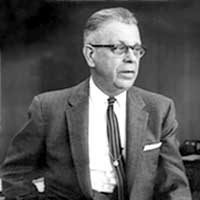 Life was not easy for Percy Lebaron Spencer, who was born to Louis and Lillian (Ottenheimer) Spencer in Howland, Maine on July 19, 1894. His father passed away when he was still a toddler and he was abandoned by his mother soon after. Spencer was brought up by his poverty-stricken uncle and aunt, who barely had enough to get by themselves. When he was seven, tragedy struck again, when his uncle died, leaving him to be the unofficial head of the household, a job he took seriously. Soon after his uncle’s passing, Spencer left school to earn a living and support himself and his aunt.
Life was not easy for Percy Lebaron Spencer, who was born to Louis and Lillian (Ottenheimer) Spencer in Howland, Maine on July 19, 1894. His father passed away when he was still a toddler and he was abandoned by his mother soon after. Spencer was brought up by his poverty-stricken uncle and aunt, who barely had enough to get by themselves. When he was seven, tragedy struck again, when his uncle died, leaving him to be the unofficial head of the household, a job he took seriously. Soon after his uncle’s passing, Spencer left school to earn a living and support himself and his aunt.
Spencer as a very curious boy, who always wanted to know how things worked, once spending days exploring a log hauler truck that broke down in front of his house, trying to figure out how it worked. That curiosity never left him, and was at the root if his inventor’s mind. Between the ages of 12 and 16 he worked at a spool mill. He left the mill upon learning about an opening at a paper factory that was going to be run on electricity. Living in a remote town, an electrically run factory was exciting and new, and something that Spencer’s mind could not resist. This was a new concept in the remote town where he lived. He didn’t know much about electricity, so he learned as much as he could about it and applied for the job of wiring the plant. He was one of three people chosen for the job. Which is amazing to me, because he was not a trained electrician, but then I guess no one else was either. Still, he had no training of any kind, and learned his job…on the job.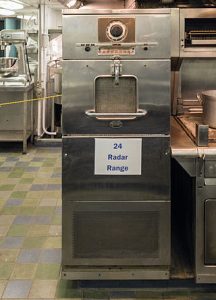
At the age of 18, Spencer’s took another turn, but this one was not a tragedy. He joined the United States Navy and it was there that he learned about wireless and radio technology. Always highly motivated, Spencer learned and gained expertise in a number of fields such as trigonometry, calculus, chemistry, physics, and metallurgy by reading extensively about them. He also became an expert in radar tube design, and worked at a company called Raytheon as the chief of the power tube division. Spencer was a great asset to Raytheon, and his expertise helped the company win a major contract from the US government to produce magnetrons for radar equipment which was became invaluable in the second world war. Under his leadership, the division expanded from a mere 15 employees to more than 5000 employees and productivity was also largely improved.
Probably the most commonly used of Spencer’s inventions in modern times, and one many people might not know was his invention, was the microwave oven. What household doesn’t have one? This invention was purely coincidental, though. One day while working at the plant, he crossed an active radar set when he noticed that the candy in his pocket had suddenly melted. His curiosity was immediately heightened, and he set about finding out how that had happened. He decided to experiment further by testing out different types of foods, such as unpopped kernels of corn. To his surprise and delight, they began to pop. Unlike others who had experienced the same, Spencer was keen to learn more about it.
Spencer began to research further, and documented his findings. Then he filed for and was granted a patent in  1945. In 1947, he produced the first commercially built microwave which was between 5 and a half to 6 feet tall and weighed around 750 pounds…not exactly the compact unit we have today. It cost between $2000 to $3000 and was initially used in restaurants, railways, and ships, as they were too bulky and expensive for home use. The early models did have some shortcomings. Meats would not cook properly in the unit. So, Spencer set about researching again, and modified his design. The first microwave for home use was developed in 1967. It cost $495 and could be fit on a kitchen counter top. So the next time you pop something into the microwave, remember that it was Percy Lebaron Spencer, who made it possible for you to do so.
1945. In 1947, he produced the first commercially built microwave which was between 5 and a half to 6 feet tall and weighed around 750 pounds…not exactly the compact unit we have today. It cost between $2000 to $3000 and was initially used in restaurants, railways, and ships, as they were too bulky and expensive for home use. The early models did have some shortcomings. Meats would not cook properly in the unit. So, Spencer set about researching again, and modified his design. The first microwave for home use was developed in 1967. It cost $495 and could be fit on a kitchen counter top. So the next time you pop something into the microwave, remember that it was Percy Lebaron Spencer, who made it possible for you to do so.
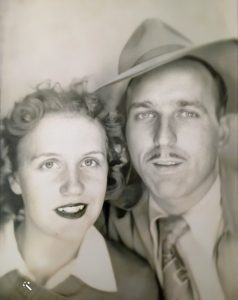
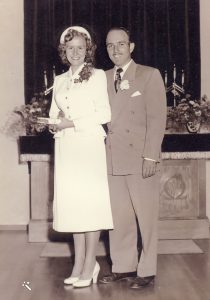 As kids, my sisters and I probably took our parents for granted, but when we look at how hard they worked to make life great for us, it almost brings tears to my eyes. My parents, Al and Collene Spencer worked very hard to give us a good life. They made sure that we got to take vacations…always wanting to make sure we saw this great nation we live in. And it wasn’t just the vacations. It was the kind of home they made for us. No matter what, we always knew that we were all equally loved. We knew that love had nothing to do with whether or not we made mistakes, or even if we got into trouble. In those days, children were spanked to teach proper manners. I know that many people these days disagree with that type discipline, but it was the era we lived in. In those days, children knew that if the neighbor told you to quit tearing something up, you had better quit. There was a measure of respect for our elders and those in authority. I miss that in our world today. Although, I live in a neighborhood, where most of the kids are respectful. We are blessed to live where we do.
As kids, my sisters and I probably took our parents for granted, but when we look at how hard they worked to make life great for us, it almost brings tears to my eyes. My parents, Al and Collene Spencer worked very hard to give us a good life. They made sure that we got to take vacations…always wanting to make sure we saw this great nation we live in. And it wasn’t just the vacations. It was the kind of home they made for us. No matter what, we always knew that we were all equally loved. We knew that love had nothing to do with whether or not we made mistakes, or even if we got into trouble. In those days, children were spanked to teach proper manners. I know that many people these days disagree with that type discipline, but it was the era we lived in. In those days, children knew that if the neighbor told you to quit tearing something up, you had better quit. There was a measure of respect for our elders and those in authority. I miss that in our world today. Although, I live in a neighborhood, where most of the kids are respectful. We are blessed to live where we do.
Mom and Dad met through her sister, Virginia Beadle, and my mom told me that it was love at first sight. She said that she tole herself that he was the most handsome man she had ever seen. Mom was still a school girl, but as soon as she could, she and Dad were married. Dad was older than mom by twelve years, a common thing in those days. He had fought in World War II, and was ready to settle down and have a family. They married and moved to Superior, Wisconsin as part of their honeymoon. My older sister, Cheryl Masterson arrived ten months after their marriage, and their family was started. I followed almost two years later, and we moved to Casper, Wyoming a couple of years later. Caryl Reed followed three years after me, Alena Stevens two years after Caryl, and Allyn Hadlock two years after Alena. Our family was complete. Dad was always outnumbered, but his girls were his little princesses. He was always patient, understanding of the needs of girls…understanding girls was a necessity for Dad.
Mom and Dad were together for 54 years of marriage before Dad’s passing on December 12, 2007. Mom 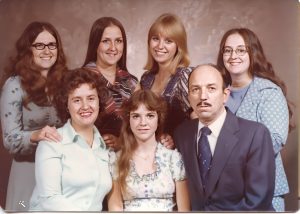
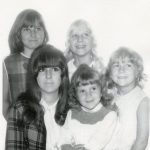 followed Dad on February 22, 2015, and now they are together again in Heaven. I’m sure they are enjoying Heaven and being together again. We miss them, but I can’t wish them back here. They would be horrified at what our world has become. Instead, we will go to join them someday, because Heaven is wonderful and we will all be happy together again, when we join them there. Today would have been Mom and Dad’s 67th Wedding Anniversary. Happy anniversary in Heaven, Mom and Dad. We love and miss you very much.
followed Dad on February 22, 2015, and now they are together again in Heaven. I’m sure they are enjoying Heaven and being together again. We miss them, but I can’t wish them back here. They would be horrified at what our world has become. Instead, we will go to join them someday, because Heaven is wonderful and we will all be happy together again, when we join them there. Today would have been Mom and Dad’s 67th Wedding Anniversary. Happy anniversary in Heaven, Mom and Dad. We love and miss you very much.

 Twenty seven years…it can seem like a lifetime, or as is the case with my daughter, Corrie Petersen, and her husband, Kevin, it can fly by so quickly that it seems impossible that it has been that many years already. Corrie and Kevin began dating when she was just 15 and he was 19. They fell in love almost instantly, and they have never looked back. They married two weeks after Corrie turned 18.
Twenty seven years…it can seem like a lifetime, or as is the case with my daughter, Corrie Petersen, and her husband, Kevin, it can fly by so quickly that it seems impossible that it has been that many years already. Corrie and Kevin began dating when she was just 15 and he was 19. They fell in love almost instantly, and they have never looked back. They married two weeks after Corrie turned 18.
So many things have changed over the course of 27 years. Two sons were born into their union, Christopher and Joshua. They were blessed with much love in their home, which they purchased almost immediately after their marriage, with the down payment coming from a car accident that occurred on their honeymoon. Kevin and his dad, Dean knew how to do bodywork on cars and to paint them, so much of the payment for their damages was left to them following the accident that was the fault of the other driver…who was an honest kid, who accepted the blame and was just thankful that no one was hurt.
Over the years, Corrie and Kevin have had a number of pets, from their first…a Dalmatian puppy, to their currents…a Scottie, two Dachshunds, and a cat. Their love of pets is quite evident, and they have been equally blessed in return. The also shared their love of pets with their sons, who both have pets in their homes, now that they are grown.
With the adulthood of their children, came more changes. the empty nest that many people dread, was not their favorite time, but they have adjusted to it, and the addition of Chris’ fiancée, his little daughter, and with 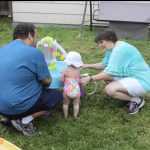
 a son to follow in November, life is getting better and better every day. Both of their sons were able to keep their jobs during the Covid-19 Pandemic, and in fact were considered “essential workers,” which helped to alleviate any financial concerns for Corrie and Kevin, concerning their children. Life has been good to them, and the love in their family is filled to overflowing. Twenty seven years have flown by, which is exactly what happens when you are having fun. Today is Corrie and Kevin’s 27th wedding anniversary. Happy anniversary Corrie and Kevin!! Have a wonderful day!! We love you both!!
a son to follow in November, life is getting better and better every day. Both of their sons were able to keep their jobs during the Covid-19 Pandemic, and in fact were considered “essential workers,” which helped to alleviate any financial concerns for Corrie and Kevin, concerning their children. Life has been good to them, and the love in their family is filled to overflowing. Twenty seven years have flown by, which is exactly what happens when you are having fun. Today is Corrie and Kevin’s 27th wedding anniversary. Happy anniversary Corrie and Kevin!! Have a wonderful day!! We love you both!!
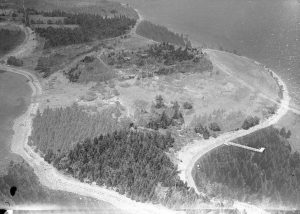 At one time or another, most of us dream of stumbling upon a buried or hidden treasure. Of course, most of those who dream about that, do so as kids, and usually after reading some story about buried treasure in a book, or watching a movie about such an event. One such buried treasure story that somehow endured for more than two centuries, is that of the Oak Island Treasure. Oak Island is located off Nova Scotia, Canada, and has been touted as the location of a money pit of buried treasure that was supposedly left there by the pirate, Captain William Kidd (1645-1701). The story seems credible enough to have led to numerous expeditions costing millions of dollars to travel to the island to search for the treasure. Unfortunately, these expeditions were to no avail, and the treasure has never been found. Perhaps it never existed, or maybe Captain Kidd or some other early treasure hunter came for it and took it away before the story even broke about its existence.
At one time or another, most of us dream of stumbling upon a buried or hidden treasure. Of course, most of those who dream about that, do so as kids, and usually after reading some story about buried treasure in a book, or watching a movie about such an event. One such buried treasure story that somehow endured for more than two centuries, is that of the Oak Island Treasure. Oak Island is located off Nova Scotia, Canada, and has been touted as the location of a money pit of buried treasure that was supposedly left there by the pirate, Captain William Kidd (1645-1701). The story seems credible enough to have led to numerous expeditions costing millions of dollars to travel to the island to search for the treasure. Unfortunately, these expeditions were to no avail, and the treasure has never been found. Perhaps it never existed, or maybe Captain Kidd or some other early treasure hunter came for it and took it away before the story even broke about its existence.
You might think that after more than 200 years, people would assume the whole thing was a hoax, give up, and move on with their lives. Well, you would be wrong. Between books and documentaries, the mystery of Oak Island’s hidden treasure is not likely to die out soon. It is even said that there must be seven deaths in search  of the treasure, before the island will yield its hold of whatever might be hidden there. To date, there have been six deaths in the searches. I don’t think that would motivate me to head out and look for it.
of the treasure, before the island will yield its hold of whatever might be hidden there. To date, there have been six deaths in the searches. I don’t think that would motivate me to head out and look for it.
Oak Island is a 140-acre privately owned island in Lunenburg County on the south shore of Nova Scotia, Canada. The tree-covered island is one of about 360 small islands in Mahone Bay and rises to a maximum of 36 feet above sea level. The island is located 660 feet from shore and connected to the mainland by a causeway and gate. The nearest community is the rural community of Western Shore which faces the island, while the nearest town is Chester.
Oak Island was, for the most part granted to the Monro, Lynch, Seacombe and Young families around the same time as the establishment of Chester on 1759. The first major group of settlers arrived in the Chester area from Massachusetts in 1761. The following year, Oak Island was officially surveyed and divided into 32 four-acre lots. Of course, if there was a treasure, it was already buried before the land was divided.
In 1965, a man named Robert Dunfield constructed a causeway from the western end of the island to Crandall’s Point on the mainland, making it more accessible to people. Oak Island Tours now owns 78% of the island, and 22% is owned by private parties. There are two permanent homes and two cottages occupied part-time on the 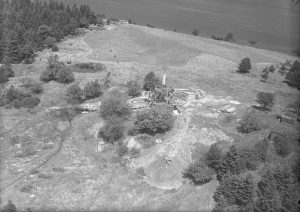 island. Since the 1850s, there have been documented treasure hunts, investigations, and excavations on Oak Island, but to no avail. There are many theories about what might be buried there, if anything really is. Areas of interest on the island with regard to treasure hunters include a location known as the Money Pit, a formation of boulders called Nolan’s Cross, the beach at Smith’s Cove, and a triangle-shaped swamp. The Money Pit area has been repeatedly excavated. Skeptics argue that there is no treasure and that the Money Pit is a natural phenomenon, but then they are probably look upon as wanting to keep any treasure for themselves. Until something is found, the treasure remains a mystery and a myth.
island. Since the 1850s, there have been documented treasure hunts, investigations, and excavations on Oak Island, but to no avail. There are many theories about what might be buried there, if anything really is. Areas of interest on the island with regard to treasure hunters include a location known as the Money Pit, a formation of boulders called Nolan’s Cross, the beach at Smith’s Cove, and a triangle-shaped swamp. The Money Pit area has been repeatedly excavated. Skeptics argue that there is no treasure and that the Money Pit is a natural phenomenon, but then they are probably look upon as wanting to keep any treasure for themselves. Until something is found, the treasure remains a mystery and a myth.
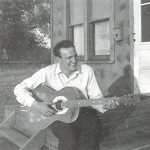
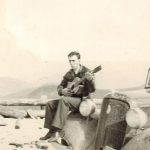 My grandson, Caalab Royce; his dad, Travis; as well as my Dad, Allen Spencer and Uncle Bill Spencer; brother-in-law, Chris Hadlock; and nephew, Ryan Hadlock all play the guitar. There may be others in the family too, but they haven’t made it public knowledge. Any time I come across a some information, on guitars or their makers, I am interested, because of these people.
My grandson, Caalab Royce; his dad, Travis; as well as my Dad, Allen Spencer and Uncle Bill Spencer; brother-in-law, Chris Hadlock; and nephew, Ryan Hadlock all play the guitar. There may be others in the family too, but they haven’t made it public knowledge. Any time I come across a some information, on guitars or their makers, I am interested, because of these people.
Adolph Rickenbacker was born on April 1, 1886 in Basel, Switzerland as Adolph Rickenbacher. Following the death of his parents, he immigrated to the United States in 1891 with relatives. He settled in Columbus Ohio and later moved to southern California. Rickenbacher was a distant cousin to America’s top Flying Ace Eddie Rickenbacker. Rickenbacher decided that the name association would be helpful to him in his chosen career, so he Anglicized both his own name and that of his company, to Rickenbacker Manufacturing Company. His company made metal bodies for the National String Instrument Corporation. These metal bodies were used to make electric guitars. Through this connection, he met George Beauchamp and Paul Barth, and in 1931 they founded the Ro-Pat-In Company.
The three men produced the first cast aluminum versions of the lap steel guitar in 1932. In 1934, they renamed their company to the Electro String Instrument Corporation. Still, this was not to be a long term business. Music instruments tend to evolve and the resulting instrument looks little like the original. Production 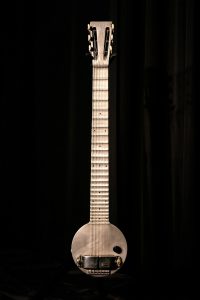
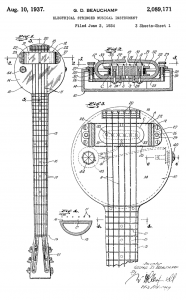 ceased in 1939, after approximately 2,700 Frying Pan guitars had been produced. Rickenbacker, who was not convinced of the guitar business’s potential, continued manufacturing until 1953. Then he sold his company to Francis Cary Hall, a forerunner of the Southern California electric guitar boom. I wonder what might have been if the Electro String Instrument Corporation had continued on. While the signature “Frying Pan Guitar” might not have held it’s popularity, many other looks have followed.
ceased in 1939, after approximately 2,700 Frying Pan guitars had been produced. Rickenbacker, who was not convinced of the guitar business’s potential, continued manufacturing until 1953. Then he sold his company to Francis Cary Hall, a forerunner of the Southern California electric guitar boom. I wonder what might have been if the Electro String Instrument Corporation had continued on. While the signature “Frying Pan Guitar” might not have held it’s popularity, many other looks have followed.
Nevertheless, the “Frying Pan Guitar” had been a wonderful career for Rickenbacker. When he finally sold the business, Adolph Rickenbacker was 67 years old. He went on to live a over 20 more years before he died from cancer in Orange County, California on March 21, 1976 at the age of 89.

 For my nephew, Shannon Moore, who is the assistant coach for the Wyoming Cowboys Football team. He is also their tight ends coach and helps with special teams too. Like most people involved with any level of education, this year has been different…to say the least. With the onset of the Covid-19 Pandemic, and the subsequent shutdown of all the schools in the nation, Shannon began working from home in March, and continued to do so until May, after the school year ended. For Shannon this meant attempting to re-invent himself and his job. In all reality, Shannon became a virtual coach…almost resembling a video game. Since the school year ended, Shannon has been on a modified schedule in the office/work from home since. I suppose with the students gone now, he can be in his office some, but when it comes to recruiting and players, things were different too, because of course, planes weren’t flying to most places, and states were locked down.
For my nephew, Shannon Moore, who is the assistant coach for the Wyoming Cowboys Football team. He is also their tight ends coach and helps with special teams too. Like most people involved with any level of education, this year has been different…to say the least. With the onset of the Covid-19 Pandemic, and the subsequent shutdown of all the schools in the nation, Shannon began working from home in March, and continued to do so until May, after the school year ended. For Shannon this meant attempting to re-invent himself and his job. In all reality, Shannon became a virtual coach…almost resembling a video game. Since the school year ended, Shannon has been on a modified schedule in the office/work from home since. I suppose with the students gone now, he can be in his office some, but when it comes to recruiting and players, things were different too, because of course, planes weren’t flying to most places, and states were locked down.
So while Shannon’s life as a football coach was very different, it was not the only part of his life that has been…different. Like many people who live very busy lives, the Covid-19 shutdown slowed life down exponentially. People found themselves at home with their families a lot. Of course, I think most people loved that part. The problem parts were that if they just sat and watched television, and many did, eating followed, along with less exercise, and weight gain. Shannon and his wife, my niece, Lindsay didn’t want to do that, so they did a lot of hiking whenever the weather allowed. They also exercised to stay fit. Also, like many people who had projects around the house that there just never seemed to be enough time for, Shannon set about painting the house, and building a beautiful deck in the back yard. Lindsay and Shannon love to entertain, and with a football team to mentor, celebrate with, and plan with, they have lots of opportunities to entertain the guys. It’s good for the team too, because many of them are away from their own family and friends, so Lindsay and Shannon have become surrogate parents, so to speak.
For Lindsay and their daughter, Mackenzie, this special time of having Shannon home, has been a gift they will always cherish. Mackenzie is going on three, and she is very much a Daddy’s Girl, so having her daddy home all day is…awesome!! Shannon is a very tender, loving man, and so good to his family. The hiking the family did gave Lindsay and Mackenzie more precious time with Shannon. They have also been able to go camping now, 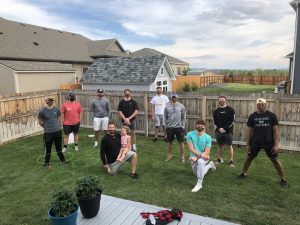
 and that has been wonderful. They are so happy that God gave Shannon the opportunity to come back to Wyoming, and to be a part of the Wyoming Cowboys Football team, and so are we, all of their family. The environment here in Wyoming has such an unhurried, stressless feel to it, and it has been wonderful to be closer to family again. Praise God!! Today is Shannon’s birthday. Happy birthday Shannon!! Have a great day!! We love you!!
and that has been wonderful. They are so happy that God gave Shannon the opportunity to come back to Wyoming, and to be a part of the Wyoming Cowboys Football team, and so are we, all of their family. The environment here in Wyoming has such an unhurried, stressless feel to it, and it has been wonderful to be closer to family again. Praise God!! Today is Shannon’s birthday. Happy birthday Shannon!! Have a great day!! We love you!!
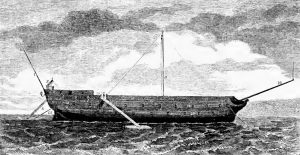 I am sometimes amazed at the ability of humans to be heinously cruel to other human beings. From murders, to slave owners, to prisons or prisoner of war camps, man has the ability to act out evil in its purest form. Still, one would not have expected such evil in the American Revolutionary War era. Well, one would be wrong. We all know that war is a horrific event, but worse than losing life and limb in battle, seems to be the fate faced by those who are captured by the enemy forces, only to be tortured and even killed.
I am sometimes amazed at the ability of humans to be heinously cruel to other human beings. From murders, to slave owners, to prisons or prisoner of war camps, man has the ability to act out evil in its purest form. Still, one would not have expected such evil in the American Revolutionary War era. Well, one would be wrong. We all know that war is a horrific event, but worse than losing life and limb in battle, seems to be the fate faced by those who are captured by the enemy forces, only to be tortured and even killed.
During the Revolutionary War, being captured by the British often meant being sent to a prison ship, the worse of which was the HMS Jersey. Over the years of the war, approximately 11,000 prisoners of war perished on the HMS Jersey. The number of American field casualties during that war was approximately 4,500. That is a stunning difference. The HMS Jersey often held thousands of prisoners at one time, in quarters that were so close, that it could be likened to being packed in like sardines in a tin. There was no light, no medical care, barely any oxygen, and very little in the way of food and clean water. The guards on the prison ships were not concerned with keeping their prisoners alive, and HMS Jersey was the worst of them all.
The little food the prisoners were given was moldy, putrefied, and worm infested. The prisoners had to choose daily to eat the horrible food, or starve. One prisoner Ebenezer Fox, who survived said, “The bread was mostly mouldy, and filled with worms. It required considerable rapping upon the deck, before these worms could be dislodged from their lurking places in a biscuit. As for the pork, we were cheated out of it more than half the time, and when it was obtained one would have judged from its motley hues, exhibiting the consistence and appearance of variegated soap, that it was the flesh of the porpoise or sea hog, and had been an inhabitant of the ocean, rather than a sty. The provisions were generally damaged, and from the imperfect manner in which they were cooked were about as indigestible as grape shot.” That pretty much says it all, I would say. The British soldiers were seemingly unaffected by the image of prisoners banging their biscuits against the deck to remove worms, because this treatment continued throughout the conflict.
Because the prisoners were kept at sea, the smell of a piece of dirt from the shoes of a soldier back from shore leave became one of the prisoners’ greatest delights. I guess that one can always find some good, even in the worst situations, if one looks for it. Captain Dring, a survivor who wrote prolifically about his experiences on the Jersey, recalled one particularly strange consolation. When someone died on the ship, their remains were usually thrown overboard, but occasionally they were allowed to be taken ashore and laid to rest. Dring was part of a group that was tasked with digging graves on land. The men chosen for this duty were ecstatic to be on land again. Dring even took off his boots simply to feel the earth underneath his feet. However, when the crew came across a piece of broken-up turf, they did something extraordinary: “We went by a small patch of turf, some pieces of which we tore up from the earth, and obtained permission to carry them on board for our comrades to smell them. Circumstances like these may appear trifling to the careless reader; but let him be assured that they were far from being trifles to men situated as we had been. Sadly did we approach and reenter our foul and disgusting place of confinement. The pieces of turf which we carried on board were sought for by our fellow prisoners, with the greatest avidity, every fragment being passed by them from hand to hand, and its smell inhaled as if it had been a fragrant rose.”
The known fate of the men on board the prison ships, and especially HMS Jersey was a slow and painful death. Most knew better than to expect to survive their ordeal. They had seen too many of their comrades die right before their eyes, to have much hope that they could make it out. To make mattes worse, the majority of the prisoners aboard the Jersey were young, inexperienced farmhands, not hardened soldiers with survival experience. Only a few of Washington’s army were soldiers with any 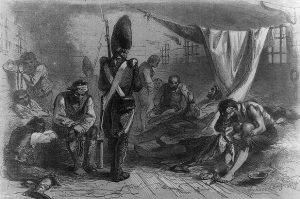 experience. The rest were provincial people, and many had never traveled beyond the limits of the small county where they lived. Imagine the horror of war, and then the conditions on HMS Jersey to the young, innocent men. The constant punishment, meager rations, lack of light, and lack of privacy could be tolerated, but the inactivity and helplessness most likely added depression and despair to their suffering. Times were different then, and there were things that were not available, but many of the things the prisoners suffered could have been avoided, especially the overcrowding and unsanitary conditions, but apparently they just didn’t care.
experience. The rest were provincial people, and many had never traveled beyond the limits of the small county where they lived. Imagine the horror of war, and then the conditions on HMS Jersey to the young, innocent men. The constant punishment, meager rations, lack of light, and lack of privacy could be tolerated, but the inactivity and helplessness most likely added depression and despair to their suffering. Times were different then, and there were things that were not available, but many of the things the prisoners suffered could have been avoided, especially the overcrowding and unsanitary conditions, but apparently they just didn’t care.
 These days, we all expect the latest new car to look different, to say the least, and strange, in some cases, but that is not really what we might have expected in the 1930s. Nevertheless, in 1933, they people might have been a little bit surprised to see the car designed by Richard Buckminster Fuller, an American architect, systems theorist, author, designer, inventor, and futurist. Fuller was born on July 12, 1895, in Milton, Massachusetts, the son of Richard Buckminster Fuller and Caroline Wolcott Andrews. The unusual middle name, Buckminster, was an ancestral family name. Like many kids, he tried numerous variations of his name. He used to sign his name differently each year in the guest register of his family summer vacation home at Bear Island, Maine. He finally settled on R. Buckminster Fuller. Not what I would have expected, but to each his own.
These days, we all expect the latest new car to look different, to say the least, and strange, in some cases, but that is not really what we might have expected in the 1930s. Nevertheless, in 1933, they people might have been a little bit surprised to see the car designed by Richard Buckminster Fuller, an American architect, systems theorist, author, designer, inventor, and futurist. Fuller was born on July 12, 1895, in Milton, Massachusetts, the son of Richard Buckminster Fuller and Caroline Wolcott Andrews. The unusual middle name, Buckminster, was an ancestral family name. Like many kids, he tried numerous variations of his name. He used to sign his name differently each year in the guest register of his family summer vacation home at Bear Island, Maine. He finally settled on R. Buckminster Fuller. Not what I would have expected, but to each his own.
Fuller married Ann Hewitt in 1917, and they would have two daughters, Alexandra born in 1918, and Allegra, born in 1927. Following the death of his daughter Alexandria in 1922 of complications from polio and spinal meningitis just before her fourth birthday, Fuller suffered with depression, even contemplating suicide. Then, he made a decision to live out his life as “an experiment to find what a single individual can contribute to changing the world and benefiting all humanity.”
In 1927, Fuller sketched the Dymaxion car under the name “4D transport.” The car was most unusual in its appearance. Part aircraft, part automobile, it actually had wings that inflated. Fuller asked a friend, sculptor, Isamu Noguchi to make more sketches of the car in 1932. The final design was an elongated teardrop body, with a rear third wheel that lifted off the ground and a tail fin. Fuller set up production of the Dymaxion car in a former Locomobile factory in Bridgeport in March 1933. The first model rolled out of the Bridgeport factory on July 12, 1933…Fuller’s 38th birthday. It had a steel chassis and a body made of ash wood, covered with an aluminum skin and topped with a painted canvas roof. It was designed to be able to reach a speed of 120 miles per hour and average 28 miles to the gallon of gasoline. The first model was sold to Gulf Oil, and dubbed the Dymaxion car. It went on display at the Century of Progress exposition in Chicago. Unfortunately, that October the professional driver Francis Turner was killed after the Dymaxion car turned over during a demonstration. The Dymaxion was cleared of responsibility in the ensuing investigation, but investors became scarce, despite the enthusiasm of the press and of celebrities such as the novelist H.G. Wells and the painter Diego Rivera.
The Dymaxion, along with the Nazi-built KdF-wagen (the forerunner of the Volkswagen Beetle), was one of several futuristic, rear-engined cars developed during the 1930s. Because of the tragic death of Francis Turner, 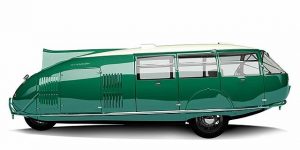 it was never mass-produced. Still, the Dymaxion helped lead to public acceptance of new streamlined passenger cars, such as the 1936 Lincoln Zephyr. The only surviving Dymaxion was featured in an exhibit dedicated to Fuller’s work at the Whitney Museum of American Art in New York City in 2008. The New York Times, in an article about the exhibit recalled Fuller’s own impressions of the Dymaxion, “‘I knew everyone would call it a car,’ he told the literary critic Hugh Kenner in the 1960s; instead, it was actually ‘the land-taxiing phase of a wingless, twin orientable jet stilts flying device.'” Interesting analogy…don’t you think?
it was never mass-produced. Still, the Dymaxion helped lead to public acceptance of new streamlined passenger cars, such as the 1936 Lincoln Zephyr. The only surviving Dymaxion was featured in an exhibit dedicated to Fuller’s work at the Whitney Museum of American Art in New York City in 2008. The New York Times, in an article about the exhibit recalled Fuller’s own impressions of the Dymaxion, “‘I knew everyone would call it a car,’ he told the literary critic Hugh Kenner in the 1960s; instead, it was actually ‘the land-taxiing phase of a wingless, twin orientable jet stilts flying device.'” Interesting analogy…don’t you think?

